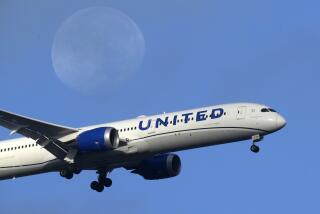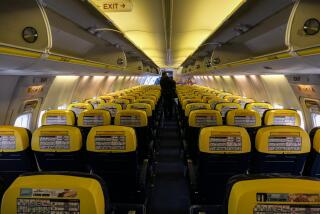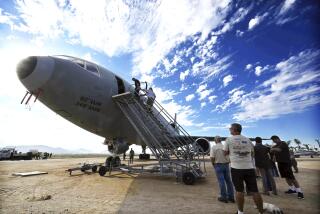What if serious illness strikes aloft?
Most of us who had boarded US Airways Flight 49 in Pittsburgh on a recent weekday evening were ready to take off for Los Angeles. But the 6 p.m. departure time had come and gone when the captain picked up the microphone and told us the flight would be even tardier: A passenger was disembarking because of a medical problem.
If youâre going to get seriously ill on a commercial airliner, doing so while the plane is still on the tarmac may improve your chances of getting prompt medical attention. But if your timing is off, the odds are still good that youâll get the care you need -- if you know whom to alert and if you check out your airline ahead of time to determine whether it is one of the growing number that maintains an air-to-ground link with medical services.
In the past five years, the popularity of such services has boomed among commercial air carriers. The services allow the flight crew to consult with on-ground specialists to determine whether basic first aid aloft is enough or whether the plane needs to be diverted.
Experts say that having the consultation services in place is better than hoping thereâs a doctor on board. The doctor may not be the specialist needed or may not step forward at all because of litigation fears. (Under the Aviation Medical Assistance Act of 1998, air carriers and non-employee passengers who help in an in-flight medical event are covered by âgood Samaritanâ protection.)
Whatever the driving force, many major carriers subscribe to the medical services or maintain their own medical staff to advise flight crews when passengers have medical problems.
âThe vast majority of our clients have signed up in the last five years,â says Brant Galloway, a spokesman for MedAire, a Tempe, Ariz.-based company that counts 39 commercial carriers among its clients for its MedLink consultation service. Some carriers, he says, were pioneers in getting the service: âATA joined up in 1988, and America West in 1989,â Galloway says.
When a passenger falls ill aloft, the first step is to call the flight attendant, says David Castelveter, a spokesman for US Airways. âFlight attendants are trained in CPR, medical emergencies and the use of a defibrillator,â which can restore normal heart rhythms, he says.
If the problem is beyond basic first aid, the flight crew will contact the medical consultation service, if one is available.
âOur typical call is about a person who is middle-aged or elderly,â says Dr. David W. Claypool, medical director of the Mayo Clinicâs World Travel Response, which provides medical consultation to Northwest Airlines and other corporate clients. âHe has been traveling all day, hasnât eaten much and almost fainted when he got up to use the bathroom. Now heâs helped back to his seat.â Claypool oversees a staff that includes about seven flight nurses and five physicians at any one time. In this typical case, hydration and observation may solve the problem.
Fainting is the top complaint and the principal reason for consultations, agrees Galloway of MedAire. (Next most common, he says, are gastrointestinal problems, cardiac complaints, respiratory difficulties and neurological problems such as stroke and seizure.) If a flight crew member calls MedLink about a fainting passenger, says Galloway, the MedLink doctor will obtain a history, asking the passengerâs age, gender, medical history and so on. The doctor makes recommendations on caring for the passenger aloft and, if needed, arranges for paramedics to meet the plane.
A recent call to the medical staff at United Airlines, which maintains its own in-house service, involved a hemophiliac patient suffering a nosebleed on a long flight, says Dr. Gary Kohn, the airlineâs medical director. He oversees a staff of 13 flight surgeons, who provide consultation to the United fleet. âIn this case, first aid worked, and there was a paramedic on board to help. We didnât need to divert.â
Diversion for medical problems, in fact, is rare, those in the industry say. About 1,000 United flights are diverted each year, Kohn says, about 100 of them for medical reasons.
In a typical year, the Mayo Clinic service fields 350 calls and diverts about 10% of the related flights, Claypool says. MedLink received 8,441 calls from commercial carriers in 2001 and diverted 442 flights, Galloway says.
Diversion may not be necessary if a medical volunteer steps forward, but a medically trained person may not be on the flight or may not want to help. MedAire has found that volunteers are stepping forward less often. In 1999, no medical volunteers were on board in 35% of cases where one was called; by 2001 that number had risen to 43%.
âThe decision to divert lies with the captain,â Claypool says. âWhen you make a decision like that, it affects the entire aircraft. Iâll tell him from a medical point of view [what is best]. Then the captain takes into account weather and other factors.
âOne time we had a call about a passenger with chest pains, but the plane was over Iranian airspace,â Claypool says. The captain, responsible for all the lives on the plane, decided to fly to Istanbul for medical help. Luckily, the passenger made it. âOur medical decision [about diversion] is one thing. The final decision is up to the pilot.â
Passengers can reduce the likelihood of needing medical help aloft, experts say, by checking in with their physician before long-distance travel, especially if they have chronic cardiac, respiratory or other conditions or a history of neurological problems. If a problem does occur during a flight, asking for help sooner rather than later can improve the odds that first aid, or more specialized help, will arrive in time to solve it.
*
Healthy Traveler appears twice a month. Kathleen Doheny can be reached at [email protected].
More to Read
Sign up for The Wild
Weâll help you find the best places to hike, bike and run, as well as the perfect silent spots for meditation and yoga.
You may occasionally receive promotional content from the Los Angeles Times.






